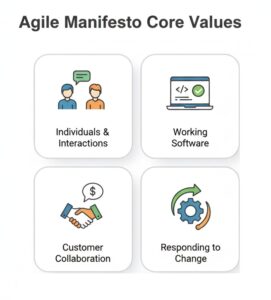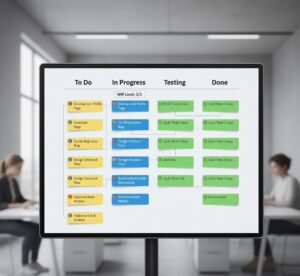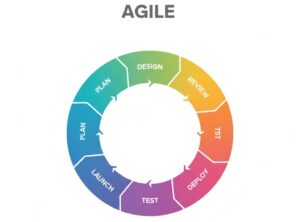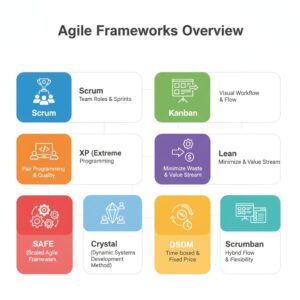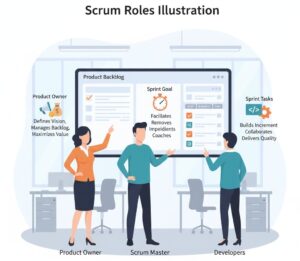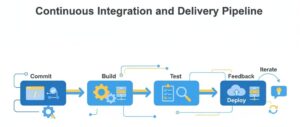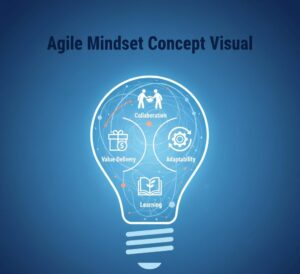In today’s fast-paced software development landscape, Agile methodology has become the heartbeat of modern project management. From startups to global enterprises, Agile drives how teams collaborate, innovate, and deliver customer value faster than ever before.
Whether you’re a fresher stepping into your first Agile project or a seasoned professional preparing for a Scrum Master or Agile Coach role, understanding Agile principles is crucial.
This comprehensive guide brings you 100 Agile interview questions and answers, thoughtfully categorized to help you ace interviews with confidence – covering everything from Agile basics and Scrum ceremonies to tools, scaling frameworks, and real-world challenges.
By the end of this guide, you’ll:
- Understand key Agile principles, values, and frameworks.
- Gain clarity on the most common interview questions asked by top employers.
- Learn practical examples that reflect real Agile scenarios.
- Be fully prepared for Agile, Scrum, or SAFe-related interviews at all experience levels.
Let’s begin your Agile mastery journey.
Table of Contents
What is Agile Methodology?
Agile is a project management and software development approach centered on iterative progress, collaboration, and adaptability. Rather than delivering software at the end of a long development cycle (as in Waterfall), Agile promotes short, repeatable cycles called iterations or sprints, where teams plan, build, test, and review continuously.
Agile Manifesto and Core Values
The Agile Manifesto (2001) laid the foundation of Agile thinking, emphasizing four core values:
- Individuals and interactions over processes and tools
- Working software over comprehensive documentation
- Customer collaboration over contract negotiation
- Responding to change over following a plan
12 Principles of Agile
Agile principles emphasize continuous delivery, collaboration, adaptability, and quality. Some key highlights include:
- Delivering valuable software frequently.
- Welcoming changing requirements, even late in development.
- Maintaining a sustainable pace and continuous attention to technical excellence.
- Promoting self-organizing teams that learn and improve continuously.
In essence, Agile methodology empowers teams to build better products faster – by keeping customers at the center and adapting to change swiftly.
Key Agile Frameworks and Methodologies
Agile isn’t a single process – it’s a family of frameworks that implement its principles in different ways. Let’s explore the most popular ones used in modern organizations.
| Framework | Core Focus | Best For |
|---|---|---|
| Scrum | Time-boxed sprints, defined roles, and ceremonies | Product development, team collaboration |
| Kanban | Visual workflow management, continuous delivery | Operations, maintenance, and support teams |
| Extreme Programming (XP) | Engineering excellence, test-driven development | Software development teams focused on code quality |
| Lean | Reducing waste, optimizing value streams | Process improvement and efficiency-driven environments |
| SAFe (Scaled Agile Framework) | Scaling Agile across large enterprises | Organizations with multiple Agile teams |
| DSDM (Dynamic Systems Development Method) | Project governance and structured Agile delivery | Enterprise-level Agile adoption |
| Crystal | Lightweight, adaptable framework focusing on team size | Small to mid-size projects |
| ScrumBan | Hybrid of Scrum and Kanban | Teams transitioning from Scrum to flow-based delivery |
Scrum vs Kanban: A Quick Comparison
| Aspect | Scrum | Kanban |
|---|---|---|
| Approach | Iteration-based | Flow-based |
| Structure | Defined roles (Scrum Master, Product Owner, Team) | Flexible roles |
| Planning | Sprint planning and backlog refinement | Continuous planning |
| Metrics | Velocity, burndown chart | Lead time, cycle time |
| Change Management | Changes not allowed mid-sprint | Changes allowed anytime |
| Meetings | Daily Scrum, Sprint Review, Retrospective | As needed |
Why Agile Matters Today
In a world of uncertainty and innovation, Agile helps teams:
- Deliver faster by focusing on working increments.
- Collaborate effectively across cross-functional teams.
- Adapt to change based on user feedback and market shifts.
- Enhance quality through continuous testing and integration.
- Boost morale by empowering self-organizing teams.
General Agile Interview Questions
These are the core Agile interview questions that appear in nearly every Agile or Scrum-related interview – from entry-level roles to senior positions. Mastering these will help you demonstrate a solid understanding of Agile fundamentals.
What is Agile methodology?
Answer: Agile is a project management and software development approach that emphasizes iterative progress, team collaboration, customer feedback, and flexibility. Work is divided into small, manageable units called iterations or sprints, allowing teams to deliver value continuously. Agile contrasts with traditional Waterfall methods by promoting adaptability and customer satisfaction through continuous improvement.
What are the core values of the Agile Manifesto?
Answer: The Agile Manifesto, created in 2001, outlines four foundational values:
- Individuals and interactions over processes and tools
- Working software over comprehensive documentation
- Customer collaboration over contract negotiation
- Responding to change over following a plan
These values prioritize flexibility, collaboration, and delivering real value over rigid procedures.
What are the 12 principles of Agile?
Answer: The 12 Agile principles guide teams to deliver value efficiently. They include continuous delivery of valuable software, welcoming changing requirements, frequent collaboration between business and development teams, sustainable development pace, and self-organizing teams. They also emphasize simplicity, reflection, and continuous improvement to enhance productivity and quality.
What are the key benefits of using Agile?
Answer: Agile brings numerous advantages:
- Faster time to market through iterative delivery.
- Increased customer satisfaction with frequent feedback loops.
- Improved team collaboration and ownership.
- Higher quality via continuous testing and integration.
- Flexibility to adapt to changing requirements quickly.
Organizations using Agile often experience better visibility and risk control across projects.
How is Agile different from the Waterfall model?
Answer: The Waterfall model is sequential – each phase (requirement, design, development, testing, deployment) follows the previous one. Agile, on the other hand, is iterative and incremental. It allows teams to revisit and refine work regularly. Agile emphasizes customer feedback, adaptability, and early value delivery, whereas Waterfall focuses on predictability and upfront planning.
What are some popular Agile frameworks?
Answer: Agile comprises several frameworks, including:
- Scrum – Time-boxed sprints with defined roles and ceremonies.
- Kanban – Visual task flow emphasizing continuous delivery.
- Extreme Programming (XP) – Focused on code quality and testing.
- Lean – Eliminates waste and optimizes processes.
- SAFe (Scaled Agile Framework) – Scales Agile across enterprises.
Each framework applies Agile principles to different contexts and team sizes.
What are the main roles in Agile?
Answer: Agile projects typically involve three core roles:
- Product Owner (PO): Defines vision, manages the product backlog, and prioritizes work.
- Scrum Master (SM): Facilitates the Agile process, removes impediments, and coaches the team.
- Development Team: Cross-functional members who deliver working increments of the product.
Together, these roles foster transparency, accountability, and collaboration.
What is an iteration or sprint in Agile?
Answer: A sprint (in Scrum) or iteration (in Agile) is a time-boxed development cycle, usually lasting 1–4 weeks. During each sprint, the team commits to completing a set of prioritized tasks from the backlog. The goal is to deliver a potentially shippable product increment by the end of the sprint, followed by a review and retrospective.
What is the Agile Manifesto and why is it important?
Answer: The Agile Manifesto is a declaration of values and principles guiding Agile software development. It promotes flexibility, collaboration, and customer-centricity. It’s crucial because it provides the philosophical foundation for all Agile frameworks – influencing how teams plan, communicate, and deliver software efficiently.
What is meant by “incremental and iterative development”?
Answer:
- Iterative development involves building software in small cycles, refining with feedback each time.
- Incremental development adds functionality step by step, ensuring each release adds tangible value.
Combined, they allow teams to learn, adapt, and deliver faster, ensuring that the product evolves with customer needs.
What are user stories in Agile?
Answer: A user story is a simple, concise description of a feature from an end user’s perspective. It follows the format:
“As a [user], I want [goal] so that [reason].”
User stories help teams understand customer needs, prioritize effectively, and break work into deliverable chunks. They form the backbone of the product backlog in Agile.
What is the difference between Agile and Scrum?
Answer: Agile is the overarching philosophy or mindset promoting iterative development and flexibility. Scrum is a specific framework that implements Agile principles using roles (Scrum Master, Product Owner, Team), events (Sprint, Daily Scrum, Review, Retrospective), and artifacts (Backlog, Increment). All Scrum teams are Agile, but not all Agile teams use Scrum.
What are some challenges teams face when adopting Agile?
Answer: Common challenges include:
- Resistance to change from traditional management.
- Lack of understanding of Agile principles.
- Unclear roles and responsibilities.
- Poor communication between business and technical teams.
- Scaling issues across multiple teams.
Overcoming these requires training, executive support, and continuous improvement.
What is a product backlog?
Answer: The product backlog is a prioritized list of all desired work or features for the product, maintained by the Product Owner. It evolves as new insights emerge and customer feedback is received. Backlog items (user stories, bugs, technical tasks) are refined regularly in backlog grooming sessions to ensure readiness for upcoming sprints.
What does “Definition of Done (DoD)” mean in Agile?
Answer: The Definition of Done is a shared agreement among the team about what “done” means for a product increment. It ensures clarity and consistency in quality. For example, a story may be considered “done” only when it’s coded, tested, integrated, documented, and accepted by the Product Owner. The DoD guarantees transparency and high delivery standards.
Scrum Framework Interview Questions
The Scrum framework is the most widely used Agile approach in organizations. Interviewers often focus on Scrum roles, events, and artifacts to test both conceptual understanding and practical experience.
What is Scrum?
Answer: Scrum is a lightweight Agile framework that helps teams deliver complex projects incrementally and iteratively. It provides a structured process with defined roles (Scrum Master, Product Owner, Developers) and events (Sprint, Daily Scrum, Review, Retrospective). Scrum encourages transparency, inspection, and adaptation, ensuring teams continuously improve and deliver customer value.
What are the three pillars of Scrum?
Answer: The three pillars of Scrum are:
- Transparency – All aspects of the process must be visible to those responsible for the outcome.
- Inspection – Teams frequently inspect progress toward goals to detect undesirable variances.
- Adaptation – Teams adjust processes or work as soon as deviations are detected.
These pillars form the foundation for continuous improvement and agility in Scrum.
What are the key roles in Scrum?
Answer: Scrum defines three key roles:
- Product Owner: Represents customer interests, manages the backlog, and prioritizes work.
- Scrum Master: Facilitates Scrum practices, removes impediments, and ensures adherence to Scrum principles.
- Developers (Team Members): Cross-functional professionals who build the product increment.
Together, these roles ensure collaboration, accountability, and delivery of value.
What is the purpose of a Sprint?
Answer: A Sprint is a time-boxed iteration (1–4 weeks) where a Scrum Team delivers a potentially shippable product increment. The goal of each Sprint is to produce value through focused work on prioritized backlog items. It provides rhythm and structure, enabling regular inspection and adaptation.
What are the main Scrum events?
Answer: The five official Scrum events (ceremonies) are:
- Sprint Planning
- Daily Scrum (Stand-up)
- Sprint Execution (Development Work)
- Sprint Review
- Sprint Retrospective
Each event serves a specific purpose to ensure transparency, collaboration, and continuous improvement within the Sprint cycle.
What happens in Sprint Planning?
Answer: Sprint Planning marks the start of a Sprint. The entire Scrum Team collaborates to define:
- Sprint Goal: What value the team aims to achieve.
- Sprint Backlog: Which product backlog items will be delivered.
- Plan for execution: How the work will be accomplished.
It aligns everyone on priorities and sets clear expectations for the Sprint.
What is the Daily Scrum?
Answer: The Daily Scrum is a 15-minute stand-up meeting where the development team synchronizes their work and plans for the next 24 hours. Each member typically answers three questions:
- What did I do yesterday?
- What will I do today?
- Are there any blockers?
The Scrum Master ensures the meeting stays focused and time-boxed.
What is a Sprint Review?
Answer: The Sprint Review occurs at the end of the Sprint. The Scrum Team demonstrates the completed increment to stakeholders, discusses progress, and gathers feedback. This event fosters transparency and ensures continuous alignment with customer needs and product goals.
What is a Sprint Retrospective?
Answer: The Sprint Retrospective is the final event in a Sprint where the team reflects on what went well, what didn’t, and how to improve. It’s a safe space for open discussion and process improvement. Common outcomes include action items to enhance collaboration, productivity, and quality in future sprints.
What is a Product Increment?
Answer: A Product Increment is the sum of all completed backlog items within a Sprint, combined with previous increments, forming a potentially releasable product. Each increment must meet the Definition of Done (DoD) and be in a usable state – regardless of whether it’s released or not.
What is a Scrum Board and how is it used?
Answer: A Scrum Board is a visual tool used to track sprint progress. It typically includes columns like To Do, In Progress, and Done. It helps the team monitor workflow, identify bottlenecks, and ensure transparency. Scrum Boards can be physical (whiteboards with sticky notes) or digital (tools like JIRA, Trello, or Azure Boards).
What is a Sprint Burndown Chart?
Answer: A Burndown Chart tracks the remaining work in a Sprint over time. It shows whether the team is on track to complete its Sprint commitment. The x-axis represents time, and the y-axis shows remaining story points or tasks. A steady downward trend indicates good progress; a flat line suggests delays or blockers.
What is the difference between Sprint Goal and Product Goal?
Answer:
- The Product Goal defines the long-term vision or objective for the product – the “why” behind development.
- The Sprint Goal defines the specific purpose of a single Sprint, aligning the team’s short-term focus.
Together, they connect strategy (Product Goal) with execution (Sprint Goal), ensuring that each Sprint moves the product closer to its vision.
What is Velocity in Scrum?
Answer: Velocity measures the amount of work (in story points or hours) a Scrum Team completes in a Sprint. It’s calculated by summing up all completed story points in previous sprints. Velocity helps forecast future sprints and guides planning, but it should never be used to compare teams – only to help each team improve predictability.
What are the key artifacts in Scrum?
Answer: The three main Scrum artifacts are:
- Product Backlog: Ordered list of everything the product needs.
- Sprint Backlog: Selected backlog items for the current Sprint, plus the Sprint Goal.
- Increment: The working product delivered at the end of the Sprint.
Each artifact increases transparency and accountability through continuous inspection and adaptation.
Agile Roles – Scrum Master, Product Owner, and Development Team
What are the primary responsibilities of a Scrum Master?
Answer:
A Scrum Master acts as a servant leader and coach for the Scrum Team. Their responsibilities include:
- Facilitating Scrum ceremonies (Daily Scrum, Review, Retrospective, etc.)
- Removing impediments that hinder the team’s progress.
- Coaching the team on Agile principles and self-organization.
- Protecting the team from external distractions.
- Ensuring continuous improvement.
The Scrum Master doesn’t manage the team; they enable it to succeed.
How does a Scrum Master remove impediments?
Answer:
A Scrum Master removes impediments by:
- Identifying obstacles through daily stand-ups or retrospectives.
- Working with stakeholders to eliminate organizational blockers.
- Facilitating communication between teams and departments.
- Implementing process improvements.
For example, if a developer lacks access to a testing environment, the Scrum Master coordinates with IT to resolve it swiftly.
What is servant leadership in Agile?
Answer:
Servant leadership is a leadership philosophy where the leader’s primary goal is to serve the team – empowering and supporting them to reach their full potential. In Agile, this means helping the team self-organize, removing obstacles, and fostering collaboration. A servant leader prioritizes team growth, autonomy, and morale over authority or control.
How does a Scrum Master handle conflict within the team?
Answer:
A good Scrum Master approaches conflict as an opportunity for growth. They:
- Encourage open communication and respect among members.
- Facilitate discussions to identify root causes.
- Use coaching techniques or retrospective sessions to resolve tension.
- Reinforce team norms and the Agile mindset.
The goal is to transform conflict into constructive dialogue that strengthens the team.
What are the key responsibilities of a Product Owner (PO)?
Answer:
A Product Owner is responsible for maximizing product value by managing the product backlog. Key responsibilities include:
- Defining and communicating the product vision.
- Creating, prioritizing, and refining backlog items.
- Collaborating with stakeholders and customers.
- Ensuring the team delivers high-value increments.
The PO bridges business strategy and technical execution in every sprint.
How does a Product Owner prioritize the backlog?
Answer:
Product Owners use techniques such as:
- MoSCoW (Must have, Should have, Could have, Won’t have).
- Value vs. Effort matrix (prioritize high-value, low-effort items).
- WSJF (Weighted Shortest Job First) in scaled environments like SAFe. WSJF = (User/Business Value + Time Criticality + Risk Reduction/Opportunity Enablement) ÷ Job Size
Example: (8 + 5 + 3) ÷ 5 = **3.2** → higher WSJF = schedule sooner.
Prioritization ensures the most valuable and time-critical features are delivered first to maximize ROI.
What is the relationship between the Product Owner and Scrum Master?
Answer:
The Product Owner focuses on what the team should build (value, priorities), while the Scrum Master focuses on how the team works (process, efficiency). They collaborate closely to ensure the team has clear goals and minimal obstacles. Their relationship should be collaborative, not hierarchical, fostering mutual respect and alignment with Agile values.
How should a Product Owner handle changing requirements during a Sprint?
Answer:
In Scrum, changes are generally not allowed mid-Sprint once the Sprint Backlog is committed. If a change is critical, the PO can:
- Discuss with the Scrum Master and team to evaluate impact.
- Cancel the Sprint if the change invalidates the Sprint Goal.
- Reprioritize backlog items for the next Sprint.
This ensures focus and predictability while remaining responsive to change.
What makes a great Product Owner?
Answer:
A great PO is:
- Visionary – understands customer needs and market trends.
- Collaborative – works effectively with both business and technical stakeholders.
- Decisive – prioritizes ruthlessly based on value.
- Empowered – has authority to make product decisions.
- Empathetic – understands user pain points.
The best POs balance strategy and execution seamlessly.
What are the characteristics of an effective Agile team?
Answer:
An effective Agile team is:
- Cross-functional – includes all skills needed to deliver value.
- Self-organizing – decides how to do the work.
- Collaborative – communicates openly and frequently.
- Committed – takes ownership of outcomes.
- Adaptable – embraces change and continuous improvement.
These qualities enable teams to deliver consistent, high-quality increments.
How does an Agile team ensure continuous improvement?
Answer:
Agile teams continuously improve by:
- Conducting Sprint Retrospectives after every iteration.
- Reviewing metrics like velocity, lead time, and defects.
- Experimenting with new tools and techniques.
- Encouraging psychological safety so members can speak up.
This ongoing cycle of reflection and adaptation drives maturity and excellence.
What is the role of developers in Scrum?
Answer:
Developers (or the development team) are responsible for building the product increment each Sprint. They:
- Plan work during Sprint Planning.
- Collaborate daily to meet the Sprint Goal.
- Maintain quality through testing and code reviews.
- Deliver potentially shippable increments by Sprint end.
They are self-managed professionals accountable for technical delivery.
How can a Scrum Master motivate a team?
Answer:
A Scrum Master motivates by:
- Recognizing achievements publicly.
- Creating an environment of trust where ideas are valued.
- Encouraging autonomy and ownership.
- Removing barriers to productivity.
- Keeping work meaningful by connecting tasks to customer value.
Motivation thrives when teams feel empowered and appreciated.
What should a Scrum Master do if the Product Owner is unavailable?
Answer:
If the PO is unavailable, the Scrum Master:
- Ensures the team has enough backlog clarity to proceed.
- Escalates the issue to management if PO absence becomes recurring.
- Avoids making product decisions on behalf of the PO.
Temporary unavailability can be managed, but consistent absence disrupts value delivery and must be addressed promptly.
How does the Scrum Master support the Product Owner?
Answer:
The Scrum Master supports the PO by:
- Helping manage stakeholder communication.
- Facilitating backlog refinement sessions.
- Coaching the PO on effective backlog prioritization.
- Ensuring transparency between PO and development team.
Their collaboration ensures alignment between product vision and execution.
Agile Ceremonies – Sprint, Stand-up, Retrospective
What are Agile ceremonies?
Answer:
Agile ceremonies are structured meetings that help teams collaborate, inspect progress, and adapt continuously. In Scrum, these include:
- Sprint Planning
- Daily Scrum (Stand-up)
- Sprint Review
- Sprint Retrospective
Each ceremony has a distinct purpose and timebox, designed to foster communication, transparency, and improvement throughout the development cycle.
What is the purpose of Sprint Planning?
Answer:
Sprint Planning marks the beginning of a Sprint, where the entire Scrum Team collaborates to decide:
- What will be delivered in the Sprint (Sprint Goal).
- How the team will accomplish the work (Sprint Backlog).
This meeting aligns the team around a clear objective and ensures everyone understands the work to be done. Typically, Sprint Planning is time-boxed to 8 hours for a one-month Sprint (proportionally shorter for shorter sprints).
What is a Sprint Goal?
Answer:
A Sprint Goal is a short, meaningful objective that gives direction and purpose to the Sprint. It answers “Why are we doing this Sprint?” The Sprint Goal helps the team stay focused even if some items change in scope. Example:
“Improve the checkout performance by 30% to enhance customer experience.”
It’s defined during Sprint Planning and guides daily decision-making.
What is a Daily Scrum (Daily Stand-up)?
Answer:
The Daily Scrum is a 15-minute meeting held at the same time every day during a Sprint. It allows the team to synchronize work and plan for the next 24 hours. Common format:
- What did I do yesterday?
- What will I do today?
- Are there any blockers?
It keeps the team aligned, identifies risks early, and promotes accountability.
Who should attend the Daily Scrum?
Answer:
Only the developers (development team) are required to attend and participate actively. The Scrum Master facilitates if needed, and the Product Owner may attend as an observer. The focus is on collaboration and planning among those doing the work, not status reporting to management.
What are common mistakes teams make during Daily Stand-ups?
Answer:
Common pitfalls include:
- Turning the stand-up into a status meeting for the manager.
- Exceeding the 15-minute timebox.
- Not discussing impediments openly.
- Lack of focus on the Sprint Goal.
- Poor attendance or distractions.
The Scrum Master must ensure the meeting stays collaborative, concise, and value-driven.
What happens in a Sprint Review?
Answer:
During the Sprint Review, the Scrum Team and stakeholders review the completed increment and discuss what to do next. The Product Owner updates the backlog based on feedback.
It’s not just a demo – it’s a collaborative working session to inspect progress toward the product goal and adapt plans accordingly. This ceremony encourages customer involvement and transparency.
How is the Sprint Review different from the Sprint Retrospective?
Answer:
- The Sprint Review focuses on the product – inspecting the work completed and gathering stakeholder feedback.
- The Sprint Retrospective focuses on the process – how the team worked together and how to improve.
Both occur at the end of a Sprint but serve distinct purposes: one optimizes the product, the other optimizes teamwork.
What is the Sprint Retrospective?
Answer:
The Sprint Retrospective is the final Scrum event in a Sprint. The team reflects on:
- What went well?
- What didn’t go well?
- What actions can we take to improve next Sprint?
It’s time-boxed (up to 3 hours for a one-month Sprint) and aims to create actionable improvements. Retrospectives are the heart of continuous improvement in Agile.
What techniques can be used in a Retrospective?
Answer:
Some popular retrospective techniques include:
- Start, Stop, Continue
- Mad, Sad, Glad
- 4Ls (Liked, Learned, Lacked, Longed For)
- Fishbone diagram (root cause analysis)
- Dot voting for prioritizing improvements
These methods make retrospectives engaging and outcome-focused.
What is timeboxing in Agile?
Answer:
Timeboxing sets a fixed duration for an activity to encourage focus and discipline. It ensures meetings don’t drag on and promotes better planning. For example, Daily Scrum is 15 minutes, Sprint Planning is up to 8 hours, etc. Timeboxing helps teams maintain rhythm and deliver consistently within predictable timeframes.
What is backlog refinement (or grooming)?
Answer:
Backlog refinement is an ongoing process where the Product Owner and team review, clarify, and estimate backlog items. Its goals are to:
- Ensure items are ready for future Sprints.
- Clarify requirements and acceptance criteria.
- Split large stories into smaller ones.
Regular refinement (usually 10% of team time) keeps the backlog healthy and Sprint Planning efficient.
What is an Agile Release Planning meeting?
Answer:
Release Planning provides a higher-level roadmap for delivering multiple Sprints’ worth of work. It helps align business objectives with delivery timelines. The meeting includes the Product Owner, Scrum Master, and stakeholders. The output is a release plan showing major milestones, goals, and estimated delivery windows – while still allowing flexibility for changes.
How does Agile handle Sprint cancellations?
Answer:
A Sprint can be canceled only by the Product Owner – usually when the Sprint Goal becomes obsolete (e.g., major business pivot or market change). When canceled:
- Completed items meeting the DoD are reviewed.
- Incomplete items return to the backlog.
Although rare, cancellations ensure focus remains on value over process.
Why are Agile ceremonies important?
Answer:
Agile ceremonies maintain transparency, inspection, and adaptation, the core Scrum pillars. They:
- Promote communication and collaboration.
- Align teams with goals and stakeholders.
- Enable continuous feedback and improvement.
Without ceremonies, teams risk losing visibility, discipline, and the collaborative rhythm that drives Agile success.
Agile Tools, Metrics, and Artifacts
What are Agile artifacts?
Answer:
Agile artifacts are key information radiators that represent work and progress within a Scrum or Agile process. The three main Scrum artifacts are:
- Product Backlog – Prioritized list of everything to be built.
- Sprint Backlog – Selected items for the current Sprint plus a plan for delivering them.
- Increment – The working product that meets the Definition of Done (DoD).
Artifacts promote transparency, accountability, and shared understanding among stakeholders.
What is the Product Backlog?
Answer:
The Product Backlog is a living, prioritized list of all features, enhancements, and fixes needed in a product. Managed by the Product Owner, it evolves as new insights or requirements emerge. The top items are the highest priority and most detailed, while lower items remain less refined. It ensures continuous alignment between product strategy and delivery.
What is the Sprint Backlog?
Answer:
The Sprint Backlog is the subset of Product Backlog items selected for a particular Sprint, along with a plan for delivering them. It belongs entirely to the Development Team. The team updates it daily as they track progress. It serves as a transparent view of what the team is working on and how they aim to achieve the Sprint Goal.
What is a product increment?
Answer:
A product increment is the sum of all completed backlog items in a Sprint, combined with prior increments. It must be usable, tested, and meet the Definition of Done (DoD). Each increment represents a potentially shippable product that delivers value – even if it’s not released immediately.
What is the Definition of Done (DoD)?
Answer:
The Definition of Done is a clear, shared agreement on what it means for work to be “complete.” It ensures consistent quality and prevents unfinished work.
Example DoD criteria might include:
- Code developed and peer-reviewed.
- All tests (unit, integration, acceptance) passed.
- Documentation updated.
- Approved by Product Owner.
A well-defined DoD helps maintain quality, transparency, and predictability.
What is a Burndown Chart?
Answer:
A Burndown Chart visually represents work remaining versus time in a Sprint or project. The x-axis shows time (days), while the y-axis shows effort (story points or tasks). It helps teams track progress and predict whether they’ll complete their Sprint commitments. A consistent downward trend indicates healthy progress; flat or erratic lines signal potential issues.
What is a Burnup Chart?
Answer:
A Burnup Chart tracks work completed against the total scope. Unlike the Burndown Chart, it shows both progress and changes in scope. This provides a clearer picture of how much work is done and how much remains. Burnup Charts are useful for highlighting scope creep and visualizing steady progress toward the goal.
What is Velocity in Agile?
Answer:
Velocity measures how much work a team completes in a Sprint – usually in story points. It’s calculated as the sum of all completed and accepted user stories from previous Sprints. Velocity helps forecast future performance and plan capacity, but it should be used for team improvement, not as a performance metric.
What is Lead Time and Cycle Time in Agile?
Answer:
- Lead Time: The total time from when a request is made to when it’s delivered.
- Cycle Time: The time it takes to complete a task once it starts.
Both metrics reflect efficiency and predictability. Lower lead and cycle times indicate faster delivery and better flow – particularly important in Kanban systems.
What are Story Points?
Answer:
Story Points are a relative estimation unit used to express the complexity, effort, and risk of a user story. Instead of hours, teams use Fibonacci-like scales (1, 2, 3, 5, 8, 13…). They encourage collaborative estimation and avoid over-precision. For instance, a story estimated at 8 points is roughly twice as complex as a 4-point story.
What is Planning Poker?
Answer:
Planning Poker is an estimation technique used by Agile teams to assign story points collaboratively. Each member selects a card (with numbers like 1, 2, 3, 5, etc.) based on their perceived effort. The team then discusses differences until consensus is reached. It combines collective intelligence, discussion, and transparency, reducing estimation bias.
What are some popular Agile tools?
Answer:
Common Agile tools used across industries include:
- JIRA – Full-featured Scrum and Kanban management platform.
- Trello – Simple Kanban-style board for task tracking.
- Azure DevOps – Integrates code, pipelines, and work tracking.
- Asana / ClickUp / Monday.com – Visual workflow management.
- VersionOne / Rally – Enterprise Agile planning tools.
These tools help manage sprints, backlogs, and reports while improving transparency and team collaboration.
What are Agile metrics and why are they important?
Answer:
Agile metrics are quantitative measures used to track performance, quality, and progress. Examples include:
- Velocity – Delivery rate.
- Lead/Cycle Time – Efficiency.
- Burndown/Burnup Charts – Progress tracking.
- Escaped Defects – Quality measure.
Metrics help teams inspect and adapt, identifying areas for improvement without turning Agile into a numbers game.
What is a Cumulative Flow Diagram (CFD)?
Answer:
A Cumulative Flow Diagram shows the status of work items over time (e.g., To Do, In Progress, Done). It’s commonly used in Kanban. The diagram’s colored bands reveal flow stability and bottlenecks. For example, a widening “In Progress” band may indicate work piling up, signaling a need to reduce WIP (Work in Progress) or rebalance workload.
How do Agile teams track quality?
Answer:
Agile teams track quality through both metrics and practices, such as:
- Defect density and escaped defects.
- Code coverage via automated testing.
- Continuous Integration (CI) results.
- Peer reviews and pair programming.
- Customer satisfaction scores (NPS, CSAT).
Maintaining quality is integral to Agile – not a separate phase – achieved through continuous testing and feedback.
Agile Testing, Project Management, and Scaling
What is Agile Testing?
Answer:
Agile Testing is a continuous testing approach integrated throughout the development lifecycle. Unlike traditional testing, which happens after coding, Agile testing ensures quality is built in from the start. Testers work alongside developers, Product Owners, and stakeholders to validate user stories early. The goal is to detect defects faster, reduce rework, and deliver higher-quality increments each Sprint.
What are the key principles of Agile Testing?
Answer:
The core principles of Agile Testing include:
- Continuous feedback from customers and the team.
- Early and frequent testing during development.
- Test-driven development (TDD) and behavior-driven development (BDD).
- Collaboration between developers, testers, and business stakeholders.
- Automation to ensure rapid and reliable feedback.
These principles align with Agile’s focus on quality through collaboration and adaptability.
What is Test-Driven Development (TDD)?
Answer:
TDD is a development practice where tests are written before the code. The process follows the cycle:
- Write a failing test.
- Write minimal code to pass the test.
- Refactor the code while keeping tests green.
This ensures code correctness, promotes modular design, and minimizes defects. TDD is central to Extreme Programming (XP) and widely used in Agile teams.
What is Behavior-Driven Development (BDD)?
Answer:
BDD extends TDD by focusing on system behavior and business outcomes. Tests are written in a natural language format (often using Gherkin syntax: Given–When–Then).
Example:
Given a user is logged in
When they click “Checkout”
Then they should see the payment page
BDD bridges communication gaps between technical and non-technical stakeholders and ensures software behavior matches user expectations.
What is Acceptance Test-Driven Development (ATDD)?
Answer:
ATDD involves collaboration among developers, testers, and business stakeholders to define acceptance criteria before coding begins. These criteria act as test cases to confirm story completion. ATDD ensures alignment with customer requirements and prevents misunderstandings, supporting built-in quality from the start.
What is Continuous Integration (CI) in Agile?
Answer:
Continuous Integration is the practice of merging code frequently (multiple times per day) into a shared repository. Each integration triggers automated builds and tests, allowing teams to detect integration issues early. CI tools like Jenkins, GitHub Actions, or Azure Pipelines help maintain code quality, reduce defects, and speed up delivery.
What is Continuous Delivery (CD)?
Answer:
Continuous Delivery extends CI by ensuring that every build is deployable at any time. Automated pipelines handle building, testing, and packaging code for release. The goal is to minimize manual intervention and make deployment a business decision, not a technical challenge. Combined with CI, it enables fast, reliable releases with reduced risk.
How do Agile teams ensure product quality?
Answer:
Agile teams ensure quality by:
- Embedding testing in every stage of development.
- Using TDD/BDD/ATDD practices.
- Implementing automated regression testing.
- Conducting peer reviews and code refactoring.
- Tracking defects and performance metrics continuously.
Quality in Agile isn’t a separate phase – it’s everyone’s responsibility throughout the process.
What are Agile test levels?
Answer:
Agile testing operates across multiple levels:
- Unit Testing – Validates individual code components.
- Integration Testing – Ensures components work together.
- System Testing – Tests the complete system functionality.
- Acceptance Testing – Confirms the system meets business requirements.
These levels ensure both functional and non-functional requirements are validated continuously.
What is Agile Project Management?
Answer:
Agile Project Management (APM) emphasizes flexibility, collaboration, and iterative progress over rigid planning. Project Managers (or Scrum Masters in Scrum environments) focus on enabling self-organizing teams, maintaining stakeholder communication, and aligning the product roadmap with business goals. Success is measured by value delivery and adaptability, not by sticking to a static plan.
What are the responsibilities of an Agile Project Manager?
Answer:
While Scrum eliminates the traditional PM role, Agile Project Managers in hybrid or scaled environments often:
- Coordinate multiple Agile teams.
- Manage dependencies and risks.
- Facilitate communication between business and delivery teams.
- Track metrics and ensure transparency.
- Support Agile adoption and culture.
They act as servant leaders ensuring collaboration across projects.
What is Scaling Agile?
Answer:
Scaling Agile refers to extending Agile practices across multiple teams, products, or departments in large organizations. It focuses on aligning teams around shared goals while preserving Agile principles. Common scaling frameworks include:
- SAFe (Scaled Agile Framework)
- LeSS (Large-Scale Scrum)
- Nexus
- Spotify Model
Each provides structure for coordination, governance, and portfolio management at scale.
What is SAFe (Scaled Agile Framework)?
Answer:
SAFe is a framework for implementing Agile at an enterprise level. It integrates principles from Agile, Lean, and systems thinking to align strategy with execution. SAFe introduces four levels:
- Team
- Program (ART – Agile Release Train)
- Large Solution
- Portfolio
SAFe emphasizes synchronization, alignment, and value stream delivery across large organizations.
What is LeSS (Large-Scale Scrum)?
Answer:
LeSS extends Scrum to multiple teams working on a single product. It maintains Scrum’s simplicity while scaling coordination. LeSS relies on one Product Owner and a shared Product Backlog for all teams. It promotes minimal overhead, shared learning, and continuous improvement at scale – staying true to Scrum’s core principles.
What are some challenges of scaling Agile?
Answer:
Common challenges include:
- Cultural resistance to Agile adoption.
- Inconsistent Agile maturity across teams.
- Coordination overhead and communication gaps.
- Unclear ownership in large structures.
- Balancing governance with autonomy.
Successful scaling requires executive buy-in, strong Agile coaching, and alignment around value streams instead of silos.
Agile vs Waterfall, Transformation & Real-World Scenarios
What are the main differences between Agile and Waterfall?
Answer:
| Aspect | Agile | Waterfall |
|---|---|---|
| Approach | Iterative and incremental | Sequential and linear |
| Flexibility | Highly adaptable to change | Difficult to change once started |
| Delivery | Continuous, after each sprint | At the end of the project |
| Customer Involvement | Continuous feedback throughout | Limited to initial and final phases |
| Documentation | Lightweight and evolving | Heavy and upfront |
Agile focuses on adaptability and collaboration, while Waterfall emphasizes planning and predictability.
When should an organization choose Agile over Waterfall?
Answer:
Agile is ideal when:
- Requirements are unclear or frequently changing.
- Projects involve complex, innovative solutions.
- Teams need rapid feedback and iterative improvement.
- Collaboration between stakeholders and developers is crucial.
Waterfall may still fit stable, regulatory, or hardware-based projects where changes are minimal and documentation is mandatory.
How do you transition from Waterfall to Agile?
Answer:
Transitioning to Agile involves:
- Educating teams and leadership on Agile principles.
- Starting small – piloting Agile in one or two teams.
- Redefining roles (PMs become Scrum Masters or POs).
- Establishing cross-functional teams and feedback loops.
- Adopting tools (JIRA, Trello) and ceremonies.
- Focusing on cultural change, not just process.
Successful transformation requires patience, executive support, and coaching to shift mindsets and behaviors.
What challenges occur during Agile transformation?
Answer:
Common challenges include:
- Resistance to change and lack of understanding.
- Incomplete adoption (doing Agile vs being Agile).
- Siloed departments and poor cross-team communication.
- Misaligned leadership expectations.
- Tool misuse without process alignment.
Addressing these requires strong Agile champions, continuous learning, and leadership commitment to the Agile mindset.
What is an Agile mindset?
Answer:
An Agile mindset is a way of thinking that embraces adaptability, collaboration, transparency, and continuous improvement. It’s not about following frameworks but embodying principles like:
- Responding to change with openness.
- Learning from feedback.
- Empowering teams to self-organize.
- Delivering value frequently.
- It transforms not just processes – but how people work and lead.
How can leadership support Agile transformation?
Answer:
Leaders play a critical role by:
- Modeling Agile behavior – openness, trust, collaboration.
- Empowering teams rather than micromanaging.
- Removing organizational impediments.
- Investing in training and coaching.
- Measuring success by value delivery, not control metrics.
Agile transformation succeeds when leaders shift from command-and-control to servant leadership.
What are Agile transformation success metrics?
Answer:
Transformation success is measured by:
- Customer satisfaction (CSAT/NPS) improvements.
- Cycle time reduction and faster delivery.
- Employee engagement and team morale.
- Increased release frequency.
- Defect reduction and quality metrics.
- Business outcomes like ROI or innovation rate.
Quantitative and qualitative metrics combined give a holistic view of Agile maturity.
How can Agile and Waterfall coexist in a hybrid model?
Answer:
Hybrid models work when:
- Upstream activities (e.g., planning, budgeting) follow Waterfall.
- Execution and delivery use Agile sprints.
For example, a large enterprise may use Waterfall for governance but Agile for development.
Frameworks like Agile-Waterfall Hybrid (Agifall) or Disciplined Agile (DA) support this coexistence, ensuring compliance and flexibility together.
How do you handle team members who resist Agile adoption?
Answer:
Address resistance by:
-
- Listening to their concerns with empathy.
- Providing training and mentorship.
- Demonstrating small wins through Agile practices.
- Involving them in decision-making.
- Showing how Agile reduces pain points (e.g., rework, delays).
Change is gradual – people adopt Agile faster when they see its value first-hand.
Can Agile work outside software development?
Answer:
Absolutely. Agile principles have been successfully applied in marketing, HR, education, finance, and manufacturing.
Frameworks like Agile HR, Agile Marketing, and Business Agility use iterative cycles, feedback loops, and cross-functional collaboration to drive value.
The essence of Agile – continuous improvement, collaboration, and adaptability – benefits any field requiring innovation and responsiveness.
Common Mistakes in Agile Interviews
Even knowledgeable candidates can lose momentum by making small but significant errors. Below are common pitfalls and how to avoid them:
Confusing Agile with Scrum
Mistake: Treating Agile and Scrum as the same thing.
Correction: Agile is a philosophy or mindset, while Scrum is one specific framework that implements Agile principles.
Memorizing terms instead of understanding principles
Mistake: Reciting definitions mechanically without showing real-world understanding.
Correction: Explain how you’ve applied Agile practices – e.g., “In my last project, we used Sprint Reviews to validate MVP features with stakeholders.”
Ignoring collaboration and people focus
Mistake: Overemphasizing tools and processes.
Correction: Agile is built on individuals, interactions, and teamwork – highlight communication, retrospectives, and stakeholder engagement.
Not knowing Agile metrics
Mistake: Being unable to discuss performance measures like velocity, cycle time, or lead time.
Correction: Learn how to interpret and improve metrics, not just define them. Interviewers value insight over jargon.
Speaking negatively about Waterfall
Mistake: Dismissing traditional models entirely.
Correction: Show balance – Waterfall has its place in regulated or predictable environments. Agile is better for adaptability, not superiority.
Lacking examples of continuous improvement
Mistake: Saying “we do retrospectives” without results.
Correction: Describe specific improvements – “After a retrospective, we reduced meeting time by 25% using focused agendas.”
Not understanding Agile roles clearly
Mistake: Mixing Scrum Master, Product Owner, and Project Manager duties.
Correction: Review Agile role definitions and their interdependencies. Know how they collaborate and balance ownership.
Forgetting customer value
Mistake: Focusing only on output (velocity, story points) instead of outcomes (customer satisfaction, business value).
Correction: Always connect your answers to customer-centric results.
Neglecting Agile mindset and culture
Mistake: Treating Agile as a checklist instead of a mindset.
Correction: Speak about adaptability, transparency, and empowerment as the true drivers of Agile success.
Overlooking scaling frameworks
Mistake: Being unfamiliar with SAFe, LeSS, or Nexus in enterprise settings.
Correction: Even if you’ve worked on small teams, know the basics of scaling Agile – it shows awareness of industry trends.
Final Tips to Crack Agile Interviews
These expert tips will help you stand out and leave a lasting impression:
Master the Fundamentals
Be crystal clear on Agile values, principles, roles, and ceremonies.
Interviewers can spot shallow understanding instantly.
Use Real-World Examples
Frame answers using the STAR method (Situation, Task, Action, Result).
Example: “During one sprint, we faced a testing bottleneck. We implemented TDD and reduced bugs by 40%.”
Highlight Soft Skills
Agile thrives on collaboration. Emphasize communication, facilitation, conflict resolution, and stakeholder management.
Showcase Tools & Technical Proficiency
Mention hands-on experience with tools like JIRA, Confluence, Azure DevOps, Trello, or CI/CD pipelines.
Know the “Why” Behind Every Practice
Don’t just say what a Scrum ceremony is – explain why it exists.
For instance, “The Daily Scrum helps us align and identify blockers early to maintain flow.”
Prepare for Scenario-Based Questions
Expect situational questions like:
“What would you do if the Product Owner keeps changing priorities mid-sprint?”
Focus on Agile principles: communication, collaboration, and adaptation.
Demonstrate Continuous Learning
Mention certifications or ongoing learning:
- Certified Scrum Master (CSM)
- Professional Scrum Master (PSM)
- SAFe Agilist (SA)
- ICAgile Certified Professional (ICP)
Lifelong learners stand out in Agile environments.
Exhibit an Agile Mindset
When asked about challenges, show humility and learning.
Agile professionals value retrospective thinking – improvement over perfection.
Learn more about Agile frameworks at Scrum.org
Frequently Asked Questions (FAQ)
These FAQs help reinforce key SEO keywords and address what candidates often search for online.
What are the four core values of Agile?
The four Agile values are:
- Individuals and interactions over processes and tools
- Working software over comprehensive documentation
- Customer collaboration over contract negotiation
- Responding to change over following a plan
What are the most common Agile interview questions?
Common topics include Agile principles, Scrum ceremonies, roles, metrics (velocity, burndown), backlog management, and real-world scenarios such as handling change, impediments, or stakeholder conflicts.
How do I prepare for an Agile interview as a fresher?
Learn the Agile Manifesto, understand Scrum roles and ceremonies, and practice answering in your own words.
Study basic tools (like JIRA or Trello) and try participating in mock Agile projects or online simulations.
What certifications are best for Agile professionals?
Popular certifications include:
- Certified Scrum Master (CSM)
- Professional Scrum Master (PSM)
- Certified Product Owner (CSPO)
- SAFe Agilist (SA)
- ICAgile Certified Professional (ICP)
Each adds credibility and practical frameworks for Agile mastery.
Can Agile work in non-software industries?
Yes! Agile principles are successfully applied in marketing, HR, education, manufacturing, and finance – anywhere teams value collaboration, adaptability, and customer focus.
What is the best way to learn Agile?
Start with the Agile Manifesto, join Scrum or Agile communities, take online courses, and apply concepts in small projects. Agile is best learned by doing, not just reading.
What are the top Agile tools to know in 2026?
The most in-demand Agile tools include JIRA, Azure DevOps, Trello, Monday.com, ClickUp, and Miro. Familiarity with automation and CI/CD tools (like Jenkins or GitHub Actions) also enhances employability.
Conclusion
Congratulations – you’ve reached the end of the 100 Agile Interview Questions and Answers (Comprehensive 2026 Guide)!
By now, you should have a clear understanding of:
- Agile principles, frameworks, and roles
- Scrum ceremonies and tools
- Testing, scaling, and transformation practices
- Interview strategies and mindset for success
Whether you’re a Scrum Master, Agile Coach, Product Owner, Developer, or Project Manager, this guide equips you with the knowledge, confidence, and examples to excel in any Agile interview.

